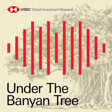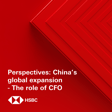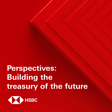Become a Creator today!Start creating today - Share your story with the world!
Start for free
00:00:00
00:00:01

Under the Banyan Tree - Female pilots, lattes, microchips and more
Herald van der Linde and Fred Neumann put Asian markets and economics in context through the quirky lens of Herald's quarterly surprising statistics, from female pilots in India to China's rapidly rising coffee of choice. Disclaimer: https://www.research.hsbc.com/R/101/dLtmvsd. Stay connected and access free to view reports and videos from HSBC Global Research follow us on LinkedIn https://www.linkedin.com/feed/hashtag/hsbcresearch/ or click here: https://www.gbm.hsbc.com/insights/global-research.
Hosted on Acast. See acast.com/privacy for more information.
Transcript
Introduction to HSBC Global Viewpoint Podcast
00:00:02
Speaker
Welcome to HSBC Global Viewpoint, the podcast series that brings together business leaders and industry experts to explore the latest global insights, trends, and opportunities.
00:00:13
Speaker
Make sure you're subscribed to stay up to date with new episodes.
00:00:16
Speaker
Thanks for listening.
00:00:17
Speaker
And now onto today's show.
00:00:24
Speaker
This is a podcast from HSBC Global Research, available on Apple Podcasts and Spotify.
00:00:29
Speaker
However you're listening, analyst notifications, disclosures, and disclaimers must be viewed on the link attached to your media player.
Quarterly Asian Market Insights
00:00:45
Speaker
Hello and welcome to Under the Banyan Tree from HSBC Global Research.
00:00:49
Speaker
I'm Fred Newman, Chief Asia Economist, joined as ever by my opposite number from the world of equities and perennial optimist, Head of Asia Equity Strategy, Harold van der Linde.
00:01:00
Speaker
Hello, Fred, and hello, listeners.
00:01:02
Speaker
We've got a fun and hopefully informative show coming up for you today.
00:01:05
Speaker
It's our quarterly list of surprising stats from the world of markets and economics here in Asia.
00:01:11
Speaker
From the global headquarters of Under the Banyan Tree here in Hong Kong,
00:01:15
Speaker
This is the podcast where we put Asian markets and economics in context.
Rapid Growth of Luckin Coffee in China
00:01:34
Speaker
So, Harold, first that I absolutely love that.
00:01:37
Speaker
I'm an addicted coffee drinker.
00:01:39
Speaker
Oh, me too.
00:01:39
Speaker
So that just jumped right at me.
00:01:41
Speaker
And that is there is a Chinese coffee store chain that's called Lukan Coffee or Luckin Coffee, depending on how you want to pronounce that.
00:01:52
Speaker
Now, that has seen explosive growth in China.
00:01:56
Speaker
And you're saying it's opened more stores in the last 12 months than there are Starbucks in China currently in total.
00:02:05
Speaker
So this is in one year that company has grown more than Starbucks has over the last 20 years in China.
00:02:10
Speaker
That's right.
00:02:10
Speaker
Because Starbucks, if I'm not mistaken, run coffee shops for it.
00:02:15
Speaker
20 odd years, almost 25 years now.
00:02:18
Speaker
This company has just doubled, I mean, built up the same number of stores as Starbucks in the last year.
00:02:24
Speaker
The craze seems to be coconut latte.
00:02:28
Speaker
I haven't had one yet.
00:02:29
Speaker
Have you tried one?
00:02:30
Speaker
I have not had coconut latte and I didn't need any coconut in my latte.
00:02:35
Speaker
But they seem to have stumbled across a trick here.
00:02:38
Speaker
And that is that they are introducing interesting flavors.
00:02:42
Speaker
Absolutely.
00:02:42
Speaker
I think they're using sometime Chinese alcoholic drinks and all these sort of things.
00:02:47
Speaker
Maybe the alcohol is not there, but those flavors go into it.
00:02:50
Speaker
So they are quite creative with some of the products.
00:02:53
Speaker
So here we are.
00:02:53
Speaker
There's a nation of famously a nation of tea drinkers that has gotten onto the coffee craze, but with a twist.
00:03:00
Speaker
And that is with a squeeze of coconut.
00:03:03
Speaker
Yeah, maybe it's a squeeze or maybe it's a big plump of it.
00:03:06
Speaker
I don't know.
00:03:07
Speaker
And also, who knows whether, you know, coconut lattes are still popular in a couple of years from now.
00:03:13
Speaker
It could also be a fad.
00:03:14
Speaker
And then, of course, the company would have to reinvent with new drinks.
00:03:18
Speaker
But they don't seem to have trouble doing that.
00:03:19
Speaker
I actually call with a suggestion here for a new product, a durian latte.
00:03:22
Speaker
I love durian.
00:03:23
Speaker
Apparently, there's a durian craze as well.
00:03:26
Speaker
Make a durian latte.
00:03:27
Speaker
Durian, of course, being that very, very, some would say smelly, other people would say more fragrant fruit from Southeast Asia.
00:03:36
Speaker
All I would request is that next time we record this podcast and you have a durian latte, you record it in a separate room.
00:03:43
Speaker
That's right.
00:03:44
Speaker
That's probably a good idea.
00:03:45
Speaker
Now, on to our next stat.
00:03:47
Speaker
And that is an interesting
Female Workforce Participation in Asia
00:03:49
Speaker
one.
00:03:49
Speaker
We're going to go to India, actually, and the big country.
00:03:52
Speaker
And you're right here.
00:03:53
Speaker
And that caught my eye.
00:03:54
Speaker
And that is that 15 percent of pilots in India are actually female, which is not a high number, all considered, but it's three times the world average.
00:04:05
Speaker
Exactly.
00:04:06
Speaker
Now, that sounds really good.
00:04:08
Speaker
And you can think, hey, aviation is booming in India and Indians are traveling around the region, not only in India, it's booming, but around the region as well.
00:04:15
Speaker
So, yeah, you need more pilots and you've got female pilots.
00:04:19
Speaker
And as you said, three times the global average.
00:04:22
Speaker
But it's unusual to see this in India, right?
00:04:25
Speaker
Because, well, maybe you know this very well, Fred.
00:04:28
Speaker
Well, the female participation rate in the workforce is actually extraordinarily low, at least in the formal sector.
00:04:35
Speaker
Of course, Indian women work.
00:04:37
Speaker
The informal sector.
00:04:38
Speaker
If you just look at the formal sector, they have a very low participation rate.
00:04:44
Speaker
In some ways, it's unusual to see then what is generally a male-dominated profession, India actually having a higher rate of female pilots than other countries.
00:04:55
Speaker
But it's interesting, you know, if you take a step back and look at Asia, there are countries where actually the female participation rate has changed dramatically and Japan stands out.
00:05:07
Speaker
Japan stands out, right.
00:05:08
Speaker
Where the last 10 years, 15 years, has gone from 40% to nearly 80%.
00:05:11
Speaker
Yeah.
00:05:13
Speaker
And that has mobilized a lot of workers, right?
00:05:15
Speaker
And that has held up growth in Japan.
00:05:19
Speaker
And so these are variables that do change over time.
00:05:22
Speaker
That's right.
00:05:23
Speaker
So you can see that Asia's mold is breaking, right?
00:05:25
Speaker
So for a long time in Japan, the number of women formerly employed was extremely low.
00:05:31
Speaker
But then the need is there.
00:05:33
Speaker
The population is shrinking.
00:05:34
Speaker
You still need people.
00:05:36
Speaker
And you can see, therefore, that...
00:05:37
Speaker
Well, Chairman Mao famously said women hold up half the sky, although in my household, my wife would probably argue she holds up 70 percent of the sky.
00:05:46
Speaker
And that's probably still an understatement for that.
00:05:49
Speaker
But you're right.
00:05:51
Speaker
In China, it's the opposite.
00:05:52
Speaker
China is the one country where female participation rates are really high.
00:05:55
Speaker
Women tend to work in China much more often than in many other countries in Asia.
00:06:00
Speaker
Yeah, and that's why China has had a much bigger mobilization of the labor force.
00:06:06
Speaker
And that obviously benefited its growth since the reopening of the Chinese economy in the early 1980s.
00:06:11
Speaker
You didn't just have men who were looking for jobs and working.
00:06:14
Speaker
The female population was as well in the former sector.
00:06:17
Speaker
And that kind of drove growth, the availability of workers.
00:06:20
Speaker
Yeah.
00:06:21
Speaker
And this is maybe, therefore, if we see that the mold changes in Japan and in China, it has worked, then maybe this is a first statistic whereby we see that, yeah, women can be employed more often in India.
00:06:33
Speaker
And that would be an additional growth driver for that country if that were to happen.
00:06:37
Speaker
And in India, it all started with the pilots.
00:06:39
Speaker
It all started with the pilots.
00:06:40
Speaker
Now, another statistic here, and that is chips are, of course, everything.
China's Semiconductor Industry
00:06:46
Speaker
Mainland China is a huge importer of chips, semiconductors.
00:06:52
Speaker
We're not talking about the potatoes, talking about semiconductors.
00:06:53
Speaker
Yeah, we're talking about semiconductors, the computer chips.
00:06:57
Speaker
And they import more than they do oil.
00:07:01
Speaker
They're huge import of oil, world's largest import of oil, but you're saying they actually import more semiconductors even than they do oil.
00:07:08
Speaker
Now there's two stories to this, I guess.
00:07:11
Speaker
First of all, they import a lot of semiconductors.
00:07:14
Speaker
And that shows you that in the very high-end tech, they are still reliant on getting these products from outside of China.
00:07:21
Speaker
They've, of course, been trying to build up their own semiconductor industry
00:07:25
Speaker
over the last 25 years.
00:07:26
Speaker
And that has worked to a certain extent, but not to the extent that they are self-sufficient yet.
00:07:31
Speaker
And I presume that is a sort of thing that I would like to change over the next couple of years.
00:07:37
Speaker
On the other hand, it also tells you that they don't import maybe as much oil.
00:07:41
Speaker
I mean, China has gone full out on hydro, nuclear, wind, solar.
00:07:47
Speaker
We have solar.
00:07:48
Speaker
plenty of supply in most of these industries, and electric vehicles.
00:07:52
Speaker
So your actual fuel bill as a country, given that you actually can source some of the energy domestically and you can use that in your cars, yeah, is therefore lower than it would be in many other countries, right?
00:08:05
Speaker
Yeah.
00:08:06
Speaker
Yeah, but there are a couple of interesting trends, I think, here as well.
00:08:09
Speaker
One is that China is obviously massively investing in semiconductor capacity more at the lower end.
00:08:17
Speaker
And there's so much investment coming through that probably China will also become a huge exporter of semiconductors in years to come, maybe more of the lower end.
00:08:27
Speaker
But there's so much capacity coming on stream that, yes, it's a big importer, but it also will be a big exporter as well in years to come.
00:08:35
Speaker
Mm-hmm.
00:08:36
Speaker
Well, this is probably a good
Korean Investments in Global Markets
00:08:37
Speaker
point to take a quick break.
00:08:38
Speaker
And when we come back, we want to look at Koreans and where they stuff their money, not under the mattress, but in certain markets.
00:08:46
Speaker
And we'll take a closer look at that.
00:08:48
Speaker
Excellent.
00:08:58
Speaker
Welcome back, everybody.
00:08:59
Speaker
I'm here joined by our flying Dutchman, the inimitable Harold van der Linde, who's again put out his very fascinating statistics.
00:09:08
Speaker
And we already discussed before the break a little bit about Indian female pilots.
00:09:13
Speaker
Yeah, yeah.
00:09:14
Speaker
coconut flavored latte in China.
00:09:17
Speaker
But one year caught my eye, and that is Koreans.
00:09:21
Speaker
Koreans, obviously, very high-saving society, lots of savings.
00:09:27
Speaker
And they're increasingly investing overseas, of course, buying foreign assets.
00:09:34
Speaker
And you're saying here that their weight of global equities in their portfolios has actually grown forever.
00:09:42
Speaker
five times since 2019.
00:09:43
Speaker
So there is a veritable equity investment surge by Korean households buying global equities.
00:09:51
Speaker
Absolutely.
00:09:52
Speaker
They have increased their exposure to global equities, mostly U.S., I suspect this is, five times since 2019.
00:09:59
Speaker
Now, we know that the Koreans during COVID years, they were very actively trending in their own market.
00:10:05
Speaker
But after COVID, that really got stuck and reduced.
00:10:09
Speaker
And therefore, they must have gone to...
00:10:11
Speaker
by US or European, global equities at least.
00:10:14
Speaker
So that's one trend we see.
00:10:16
Speaker
What we also see in some markets, Korea, but in Taiwan, for example, this is a big trend as well.
00:10:21
Speaker
People don't buy stocks, they buy ETFs.
00:10:24
Speaker
So they just buy some large ETF here and there and that's their exposure.
00:10:30
Speaker
How do you explain why is a
00:10:32
Speaker
Koreans especially eager to buy global equities?
00:10:36
Speaker
Why are not Indians or Vietnamese or Singaporeans?
00:10:42
Speaker
First of all, you have sometimes capital controls to a certain extent.
00:10:45
Speaker
China has got strong capital controls.
00:10:46
Speaker
But actually in India, for example, there's a limit on how much money you can bring out as a retail investor out of India.
00:10:51
Speaker
So there are to a certain extent some controls onto that.
00:10:55
Speaker
Secondly, we see that there tends to be a trend whereby first if people start to buy equities, and we see this for example in Indonesia now, in Thailand, they first start with their own local market.
00:11:07
Speaker
Those are the companies they're most acquainted to.
00:11:09
Speaker
They see them every day.
00:11:10
Speaker
So it seems that that's where the comfort is.
00:11:12
Speaker
And then they go regional or global.
00:11:14
Speaker
And probably what helped is that the U.S. market has simply performed extremely well.
00:11:18
Speaker
Yeah, and they've sucked in more money.
00:11:20
Speaker
And, of course, Korea is a very tech-savvy society.
00:11:24
Speaker
U.S. tech names have done very well.
00:11:25
Speaker
You know, they're probably...
00:11:27
Speaker
There is an affinity there, if you will, as well.
00:11:30
Speaker
One point I would add here, it's interesting, you're talking about Korean households buying global equities.
00:11:35
Speaker
That's a capital outflow out of Korea.
00:11:38
Speaker
And that means there's demand for dollars in Korea and the currency there for weekends.
00:11:43
Speaker
And what we've seen actually in recent weeks is that the National Pension Fund
00:11:49
Speaker
is actually reversing this, is buying Korean assets, selling foreign assets to offset some of that drain on the currency.
00:11:57
Speaker
So it's interesting, yes, Korean households are moving abroad, but the pension system is slightly tilting back at the moment to kind of offset that.
00:12:06
Speaker
So there's interesting counterflow.
00:12:07
Speaker
That's interesting because for a household, of course, they have money in the pension fund as well.
00:12:12
Speaker
So net net, their full exposure to global equities might definitely not be as high as they think it is.
00:12:17
Speaker
Yes.
00:12:17
Speaker
That's right.
00:12:18
Speaker
Yeah, yeah.
00:12:18
Speaker
So this is, of course, a disclaimer with Herald statistics.
00:12:21
Speaker
You always need to have an economist who cross-checks them.
00:12:24
Speaker
These things.
00:12:25
Speaker
Make sure that the next thing is right.
00:12:26
Speaker
Look, another fascinating statistic.
00:12:28
Speaker
And really, you have a knack for finding those interesting twists in data.
00:12:35
Speaker
And this is going back to China, the land of superlatives and values.
00:12:40
Speaker
And coconut lattes.
00:12:41
Speaker
And coconut lattes as well.
00:12:42
Speaker
Now, EV batteries.
China's Battery Production Dominance
00:12:44
Speaker
There's a maker of EV batteries called CATL.
00:12:47
Speaker
Correct.
00:12:48
Speaker
And that is probably the largest global auto battery maker for electric vehicles.
00:12:55
Speaker
And that CATL can produce one battery cell every second.
00:13:01
Speaker
And one battery pack every two and a half minutes.
00:13:05
Speaker
So imagine the number of batteries that this particular company makes, either packs or whatever, that continues to roll up.
00:13:13
Speaker
And this is 24 hours.
00:13:14
Speaker
This is 24-7, I would imagine.
00:13:16
Speaker
This is not just during 10 to 4 on the Monday afternoons.
00:13:21
Speaker
This is around the clock.
00:13:22
Speaker
Exactly.
00:13:23
Speaker
And these batteries, of course, to a large extent, go into electric vehicles.
00:13:27
Speaker
And in China, 50% of the cars now being sold are electric vehicles.
00:13:31
Speaker
That's growing rapidly.
00:13:34
Speaker
In a couple of years' time, there will hardly be any combustible engine car being sold anymore in China.
00:13:39
Speaker
So, yeah, that goes into the car industry.
00:13:41
Speaker
And, of course, that's also being exported around the world.
00:13:44
Speaker
It's Chinese companies that export their EVs and, to a certain extent, foreign companies that buy these batteries as well because they do not have the capabilities.
00:13:52
Speaker
And we should probably also say that scale, obviously, initiative massive scale operations, confers competitiveness in this business.
00:14:00
Speaker
So it's partly about the technology you have, but also the amount of batteries you can build, which then reduces the unit price.
00:14:07
Speaker
Unit cost, and therefore you are the most cost competitive producer on the planet in certain batteries.
00:14:14
Speaker
That makes it easier to export or go to European or US companies and say, listen, why don't we just make the battery for you?
00:14:20
Speaker
We can do this much cheaper for you and it allows you to reduce your car price again.
00:14:24
Speaker
Now, total capacity for electric vehicle in China overall, not just for CATL, but if you take all companies, is actually enough to satisfy global demand for any country.
00:14:36
Speaker
That's how massive the capacity is.
00:14:39
Speaker
Which is very, very impressive.
00:14:41
Speaker
But is there a risk that we might find that there's new technologies coming through in the next few years, breakthrough technologies, different types of batteries are much, much better that would upend that?
00:14:51
Speaker
Or do you think this is such a dominant technology now?
00:14:54
Speaker
Well, I think they seem to be in the cutting edge.
00:14:56
Speaker
So I've been told, for example, that some of the batteries they make in the past couldn't go into...
00:15:01
Speaker
very low temperatures.
00:15:03
Speaker
So if it was extremely cold, these batteries would freeze, but they've now been able to adjust these batteries.
00:15:08
Speaker
So even if it's minus 30, they can still run.
00:15:11
Speaker
It's the same in tropical countries.
00:15:12
Speaker
If they overheat, they can still deal with it.
00:15:14
Speaker
So it seems on the cutting edge of it.
00:15:16
Speaker
Also, some of these batteries allow an EV now to run for something like 800 kilometers or close to a thousand kilometers.
00:15:21
Speaker
So I think on the battery front, they seem to be cutting edge.
00:15:25
Speaker
The risk is, of course, that another technology emerges.
00:15:28
Speaker
Think about hydrocars or maybe something that we don't even know yet, something that emerges over the next 5, 10, 15 years, just like the combustible engine companies struggle to then move into EVs.
00:15:40
Speaker
It might well be that the EVs at some point in time struggle to move in whatever the next technology is going to be.
00:15:45
Speaker
Yeah, there's always risk.
00:15:47
Speaker
Or another possibility might be solar panels.
00:15:49
Speaker
Maybe they become so good that you don't need a battery.
00:15:52
Speaker
You just, even at night, there's enough light around for these to drive.
00:15:56
Speaker
But then you probably still need to store it.
00:15:57
Speaker
So you need some sort of battery, I guess.
00:15:59
Speaker
But yeah, but you have to be open.
00:16:01
Speaker
And that depends very often, not just on the company, but also the management of these companies.
00:16:05
Speaker
There's a new technology.
00:16:06
Speaker
Are they open up to quickly move into that, right?
00:16:09
Speaker
Yeah.
00:16:09
Speaker
But the Chinese economy, as we discussed, is highly innovative.
00:16:12
Speaker
And, you know, with its batteries or coconut lattes, you know, there's always new stuff coming out of China.
00:16:18
Speaker
And so I'm sure you'll be on top of these statistics and we'll check back in with you next time you have your favorite stats out.
00:16:25
Speaker
You've got plenty more here.
00:16:26
Speaker
We only scratched the surface.
00:16:27
Speaker
So thanks again, Harold.
00:16:29
Speaker
And we'll pick this up again in the future.
00:16:32
Speaker
Good idea.
00:16:36
Speaker
Well, that's about all we've got time for on this episode of Under the Banyan Tree.
00:16:40
Speaker
There are plenty more quirky facts and stats on Asian markets and economics in our latest edition of my signature report, The Flying Dutchman.
00:16:49
Speaker
Do check those out on the Global Research mobile app or the website.
00:16:53
Speaker
Indeed, and we'll be back next week with a podcast recorded live in front of a studio audience in Singapore with special guests Pranjo Bhandari, Joey Wang, and Joey Chu from our Asia research team over there.
00:17:05
Speaker
Make sure you join us for that, and we'll talk to you then.
00:17:34
Speaker
Thank you for joining us at HSBC Global Viewpoint.
00:17:37
Speaker
We hope you enjoyed the discussion.
00:17:40
Speaker
Make sure you're subscribed to stay up to date with new episodes.










